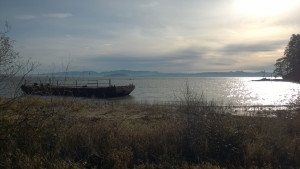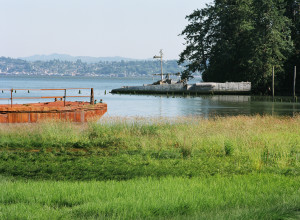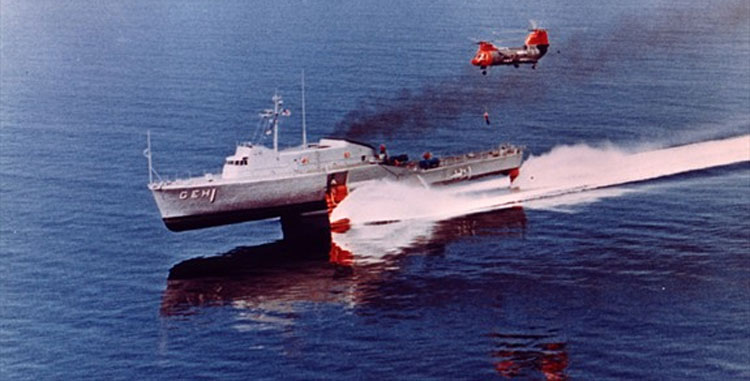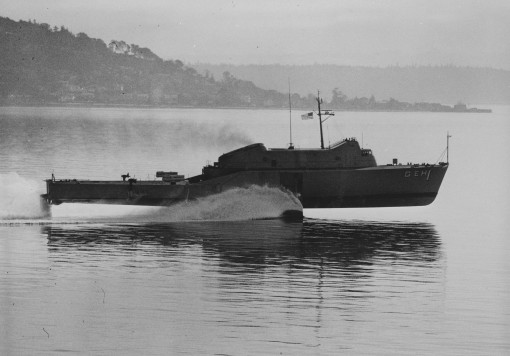Finding the Ship That Flew
Podcast: Play in new window | Download | Embed
Subscribe: Apple Podcasts | Spotify | Amazon Music | RSS | More
There are dozens of things to see and do on the Lewis and Clark Trail Highway in southwest Washington (see here and here for just a few examples), but surely one of the most unique lies just outside a tiny berg called Knappton on the bank of the Columbia River. If you head west from Knappton Cove you might spot a rusty barge parked in a shallow bay called Hungry Harbor. There is something else very interesting about this harbor that caused me to stop and snap a few pictures, thinking I’d look it up on the internet when I got home. What I learned was yet another stunning bit of our history that found its final resting place along the Columbia.
 The rusty barge is interesting enough, tied up to the shoreline and in all likelihood unusable. It makes for a great photo opportunity with the Columbia River in the background. But look around closely and you’ll see the hull of another wrecked ship half buried in the muck just a few hundred yards away. You can’t really get to it without violating the “KEEP OUT” and “NO TRESSPASSING” signs spray painted on particleboard, so getting a quality photo is difficult. But what you’re looking at is actually what remains of what was, in its time, the world’s largest hydrofoil: the USS Plainview…also known as the ship that flies.
The rusty barge is interesting enough, tied up to the shoreline and in all likelihood unusable. It makes for a great photo opportunity with the Columbia River in the background. But look around closely and you’ll see the hull of another wrecked ship half buried in the muck just a few hundred yards away. You can’t really get to it without violating the “KEEP OUT” and “NO TRESSPASSING” signs spray painted on particleboard, so getting a quality photo is difficult. But what you’re looking at is actually what remains of what was, in its time, the world’s largest hydrofoil: the USS Plainview…also known as the ship that flies.
 Built by Lockheed Shipbuilding in Seattle in 1964, the Plainview was named for the cities of Plainview, New York, and Plainview, Texas. She was also the United States Navy’s first hydrofoil research ship. Remember when you could watch the hydrofoils cruising up and down Puget Sound and the Columbia River? Yeah, neither do I. The theory was sound: surface area and friction reduces a boat’s speed in the water, so eliminating those would make a faster boat. But for some reason the technology never really took off (so to speak).
Built by Lockheed Shipbuilding in Seattle in 1964, the Plainview was named for the cities of Plainview, New York, and Plainview, Texas. She was also the United States Navy’s first hydrofoil research ship. Remember when you could watch the hydrofoils cruising up and down Puget Sound and the Columbia River? Yeah, neither do I. The theory was sound: surface area and friction reduces a boat’s speed in the water, so eliminating those would make a faster boat. But for some reason the technology never really took off (so to speak).
According to Wikipedia, Plainview carried out long range experimental programs to evaluate the design principles of hydrofoils and to develop and evaluate tactics and doctrine for hydrofoils, particularly in anti-submarine warfare, and helped to determine the feasibility of hydrofoil operations in high seas. By 1978, she had evidently served her purpose and was decommissioned by the U.S. Navy and sold for scrap to a Tacoma company. After they’d stripped her of everything useable, she “ended up” abandoned in Hungry Harbor on the Columbia (I put that in quotes because former U.S. Navy warships aren’t just accidentally forgotten. Somebody made the decision to scuttle her there).
You can read more of the story on Wikipedia’s page or on a number of other pages dedicated to keeping the memory of the hydrofoil era alive. Perhaps the most intriguing thing I found while researching the ship is this YouTube video of the Plainview in full operation. The amazing footage shows the (then brand new) Space Needle in the background as the Plainview motors out into Elliott Bay and takes off, flying low and heavy over the water like a majestic pelican. Then, you see pictures of the Plainview being scavenged using the very same rusty barge we saw earlier.
As the son of two Navy veterans (and an Army veteran myself), I’d like to salute the Plainview for her service to America, and hope that someday – like the Kalakala – she can be laid to rest the right way.



It still resides in the mudflats near Astoria. I trekked out there today and took pictures of it.
That must have been exhilarating. And terrifying at the same time! Thanks for sharing your memories, Cort!
I was the ET1 assigned to Plainview. I was one of the pilots and often “flew” and drove her hullborne. I was flying her on the last flight when the starboard foil linkage failed. Needless to say that was quite exciting at 45 knots. Sorry to see that they never conducted a repair.
Thanks for the background story, Michael! I talked a little bit about that in the podcast episode about the Plainview. Hey, do you have a picture of that tie bar you could send me? I’d love to post it with your comment!
What remains of her still sits listing in the mud. She was purchased after scrapping, and brought to Astoria with the idea of converting her to a mother ship for a migratory Alaska gill-net fleet. The fishing boats would be loaded on the deck and transported through the passage along the Canadian coast to the Alaskan fishing grounds, and back at the end of the season. The Plainview sat on the Astoria waterfront in Young’s Bay awaiting that re-purposing. It never happened. She was later moved to Hungry Harbor on the Washington side of the Columbia, to be slowly and intermittently dismantled. She is now viewed as a pollution threat.
Side note: I never walked her decks, but i have her on a tie bar that was found under the floor mat in a used car! A fragment of naval history!
Pingback: Day 26: Oregon Coast 101 – The Ride of Life
Joe Cox, yes, it still sits there. As a kid I remember it being in Hammond, OR….saw it every time we went to Dairy Queen. 🙂
Wow, thanks for that insight! I can see how time and retelling of the story could exaggerate the Plainview’s speed.
The High Point was considered OUR sister ship. Plank holder of Plainview. And no, we never did 100 knots, closer to low sixties, and then yes it did begin to shudder somewhat. Sumi Arimi was running HYSTU then I believe.
Are you sure the Plainview was built in 1964? When I was 17 my Dad ‘snuck’ me into the shipyard to make money for college tuition. That was June of 1966. My first job in the shipyard was working on the Plainview. I remember operating a 50 ton hydraulic router cutting out ‘lightening’ holes in the aluminum framing. Other times I operating a chipping gun taking out welds in the aluminum super structure that were judged to be defective.
Once I recall the wing wall of the drydock (where the Plainview was being worked on) filled with “white hats” from Lockheed in California. They were on a junket to see the hydrofoil. The cockpit of the Plainview was set up with seats and gauges and throttles and each supervisor took a turn sitting in the pilot’s seat.
As I was a fairly good sized kid, I also got overtime pay working through lunch one day to raise one of the foils with a chain fall. Several years later I saw what I thought was a stripped down Plainview docked on the Oregon side of the Columbia near Interstate 5. I did see the Plainview up on its’ foils one time on Elliot Bay/Puget Sound. It was quite a sight.
Do you know if it is still beached on the Columbia near Ilwaco? I am 68 years old and planning a trip to drive down to see it this summer.
Thanks for your information regarding the Plainview.
Joe Cox
PS. Other remembrances: I learned to play baseball on the front lawn of Sea-Tac Airport around 1962. I learned to ride a dirt bike on the I-5 right-of-way as it was being built. I worked on large stainless steel tunneling doors fabricated at Lockheed for the underground nuclear testing in Nevada. Helped build the Polar Star (red-hulled ice breaker) and had lunch several times in the “ice house” on top of the mast. I ran a crew at Todd Shipyards that constructed the operating platform for the N reactor at Hanford. I was 150’ from one of the big Whirley’s (crane) at Todd when it got a 35-ton load too far off path and fell over. Did a survey of large Western Red Cedar trees along Big Beaver Creek for Seattle City Light when they were considering raising Ross Dam by 122.5’. I was a volunteer trail monitor for DNR and hiked Mt. Si 50 times a year for several years. I’ve played handball for almost 50 years around the NW and nationally (winning over 100 tournaments, national titles in the US and Canada and a silver medal at the World Championships in Dublin, Ireland). When Safeco Field opened in 1999 I had been to baseball games at all 30 active major league parks and slept out overnight on first avenue to be the first paying customer into Safeco Field. (Sorry for TMI, but I’ve never put all this down in one place). Best wishes.
Mr. O’Blazney – 100 knots?!?!? Seriously??? Wow!!!
Thanks for weighing in! That’s really helpful information to know. Thank you for your service as well, and I’m glad you got to experience the Plainview’s decommissioning.
Both the Plainview and the High Point were a class of their own, they had no sister ships. I was part of the decommissioning crew of the Plainview and being a member of her crew was a high point of my naval career.
Every time it got to 100 knots, it would start rattling, and we’d have to go back and figure out why. We never did. Don Reig was the head of HYSTU, a good man.
I couldn’t tell you if the USS Plainview had a sister ship. In my brief Google research, I did not come across that information. But if you find out more, please let me know! Thanks for reading.
Wasn’t “The Plainview” the sister of “The Highpoint”? I watched her being mothballed, at Bremerton. Later I heard the Coast Guard took over the Highpoint.